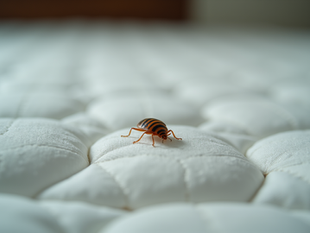
Steps to Take When Dealing with a Bedbug Infestation
0
4
0
Bedbugs are tiny, nocturnal insects that feed on human blood. They are notoriously difficult to eliminate once they invade a home. Understanding how to deal with a bedbug infestation can save you time, money, and discomfort. In this comprehensive guide, we will explore the steps to take when faced with a bedbug problem.
Understanding the Bedbug Problem
Bedbugs are common in many parts of the world. According to the National Pest Management Association, bedbug infestations in the United States have increased by over 20% in recent years. They can be found in homes, hotels, and public transportation. Recognizing the signs of an infestation is crucial for prompt action. Look for:
Tiny, red bite marks on your skin.
Dark spots on sheets and mattresses.
A sweet, musty odor.
By being vigilant, you can catch an infestation in its early stages, which will make it easier to treat.

Early Intervention: Bedbug Removal
Taking immediate action is critical if you suspect a bedbug infestation. Here are detailed steps to address the problem:
Step 1: Identify and Isolate
Begin by identifying the extent of the infestation. Inspect your sleeping areas and nearby furniture, focusing on:
Mattresses
Bed frames
Couches
Carpets
Once you identify infested areas, isolate them by removing items from that space. Seal clothing and linens in plastic bags to prevent spreading the bedbugs to other parts of the home.

Step 2: Clean Thoroughly
Cleaning is a vital step in battling bedbugs. Start with thorough vacuuming:
Use a high-powered vacuum to clean beds, carpets, and any cracks where bedbugs might hide.
Dispose of the vacuum bag immediately in a sealed plastic bag.
Next, wash all bed linens, clothes, and fabric items in hot water. Dry them on high heat for at least 30 minutes to kill any bedbugs or eggs.
Step 3: Treatment Options
There are several treatment options available for bedbug removal. Here are the most common:
Chemical Treatments
These involve using insecticides specifically designed for bedbugs. It is crucial to follow instructions carefully.
Apply insecticides directly to the infested areas.
Only use products labeled for bedbug control.
Heat Treatments
Bedbugs cannot survive at temperatures above 120°F. Hiring a professional service to conduct heat treatments can effectively rid your home of these pests.
Natural Remedies
Many people seek natural solutions to bedbug infestations. While they may not be as effective as professional treatments, some natural methods include:
Diatomaceous Earth: This powder dehydrates bedbugs when they come into contact with it.
Essential oils: Oils such as tea tree oil and lavender can repel bedbugs but may not completely eradicate them.
Step 4: Professional Help
If the infestation persists despite your efforts, it may be time to call in professionals. Look for pest control services specializing in bed bug removal. They have the expertise and tools to eliminate bedbugs effectively, and many offer guarantees on their services.
If you're located in Connecticut, exploring options for bed bug removal can be particularly useful, especially given the rising numbers of infestations in urban areas.

Prevention Tips
Once you have dealt with an infestation, the focus should shift to prevention. Here are some proactive measures to keep bedbugs at bay:
Regular Inspections
Make regular inspections of your home a habit. Check for signs of bedbugs, especially after traveling or bringing second-hand items home.
Protective Covers
Invest in quality mattress and box spring encasements. These barriers make it harder for bedbugs to enter and exit your bedding.
Careful Travel Practices
Bedbugs are often picked up during travel. Use these practices when staying in hotels:
Inspect the bed for signs of infestation before unpacking.
Keep your luggage off the floor and placed on a hard surface.
Wash all clothing upon returning from a trip.
Final Thoughts: Staying Vigilant
Dealing with a bedbug infestation can be a daunting task, but with the right approach, it is manageable. Early detection and prompt actions are critical in controlling the situation. Regular cleaning, careful inspections, and appropriate treatments will reduce the chance of future infestations.
For persistent problems, seek out professional help, especially reliable services that specialize in bed bug removal connecticut. Remember that vigilance is key; being proactive about inspections and preventive measures can save you from future headaches.







